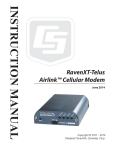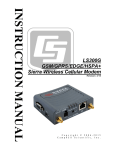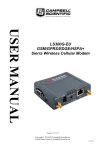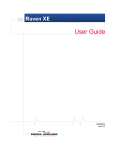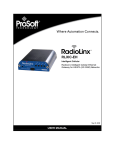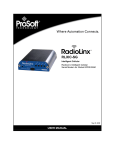Download Campbell Raven II Product manual
Transcript
RavenXTG GPRS/EDGE Sierra Wireless Cellular Modem Revision: 12/13 C o p y r i g h t © 2 0 0 6 - 2 0 1 3 C a m p b e l l S c i e n t i f i c , I n c . Warranty “PRODUCTS MANUFACTURED BY CAMPBELL SCIENTIFIC, INC. are warranted by Campbell Scientific, Inc. (“Campbell”) to be free from defects in materials and workmanship under normal use and service for twelve (12) months from date of shipment unless otherwise specified in the corresponding Campbell pricelist or product manual. Products not manufactured, but that are re-sold by Campbell, are warranted only to the limits extended by the original manufacturer. Batteries, fine-wire thermocouples, desiccant, and other consumables have no warranty. Campbell’s obligation under this warranty is limited to repairing or replacing (at Campbell’s option) defective products, which shall be the sole and exclusive remedy under this warranty. The customer shall assume all costs of removing, reinstalling, and shipping defective products to Campbell. Campbell will return such products by surface carrier prepaid within the continental United States of America. To all other locations, Campbell will return such products best way CIP (Port of Entry) INCOTERM® 2010, prepaid. This warranty shall not apply to any products which have been subjected to modification, misuse, neglect, improper service, accidents of nature, or shipping damage. This warranty is in lieu of all other warranties, expressed or implied. The warranty for installation services performed by Campbell such as programming to customer specifications, electrical connections to products manufactured by Campbell, and product specific training, is part of Campbell’s product warranty. CAMPBELL EXPRESSLY DISCLAIMS AND EXCLUDES ANY IMPLIED WARRANTIES OF MERCHANTABILITY OR FITNESS FOR A PARTICULAR PURPOSE. Campbell is not liable for any special, indirect, incidental, and/or consequential damages.” Assistance Products may not be returned without prior authorization. The following contact information is for US and international customers residing in countries served by Campbell Scientific, Inc. directly. Affiliate companies handle repairs for customers within their territories. Please visit www.campbellsci.com to determine which Campbell Scientific company serves your country. To obtain a Returned Materials Authorization (RMA), contact CAMPBELL SCIENTIFIC, INC., phone (435) 227-9000. After an application engineer determines the nature of the problem, an RMA number will be issued. Please write this number clearly on the outside of the shipping container. Campbell Scientific’s shipping address is: CAMPBELL SCIENTIFIC, INC. RMA#_____ 815 West 1800 North Logan, Utah 84321-1784 For all returns, the customer must fill out a “Statement of Product Cleanliness and Decontamination” form and comply with the requirements specified in it. The form is available from our website at www.campbellsci.com/repair. A completed form must be either emailed to [email protected] or faxed to (435) 227-9106. Campbell Scientific is unable to process any returns until we receive this form. If the form is not received within three days of product receipt or is incomplete, the product will be returned to the customer at the customer’s expense. Campbell Scientific reserves the right to refuse service on products that were exposed to contaminants that may cause health or safety concerns for our employees. Table of Contents PDF viewers: These page numbers refer to the printed version of this document. Use the PDF reader bookmarks tab for links to specific sections. 1. General Description....................................................1 2. Establish Cellular Service ..........................................1 2.1 RavenXTG Cellular Coverage/Service Requirements .........................1 3. Specifications .............................................................2 3.1 RavenXTG Specifications....................................................................2 4. Configuration ..............................................................3 4.1 4.2 4.3 Base Station Requirements for RavenXTG..........................................3 Datalogger Site Equipment ..................................................................3 Wiring and Connections.......................................................................6 4.3.1 Modem Connections Using PN 18663 Null Modem Cable ..........6 4.3.2 Modem Connections Using the SC105 .........................................7 4.3.3 Modem Connections Using the SC932A ......................................8 4.4 Power Considerations...........................................................................9 4.5 Automatic Provisioning (Activation) ...................................................9 5. Using AceManager to Program the Modem ...........11 5.1 Configuring the RavenXTG for Dynamic IP .....................................15 6. LoggerNet/PC400 Software Setup...........................17 6.1 Test the Cellular Connection..............................................................19 7. Troubleshooting........................................................20 Appendices A. AceManager Setup without Template File............ A-1 B. Installation of SIM Card in the RavenXTG ............ B-1 C. Configuring the RavenXTG Modem for PPP ........ C-1 i Table of Contents D. EmailSend Using the Gmail Outgoing SMTP Server.....................................................................D-1 D.1 D.2 D.3 Setting up a Gmail Account............................................................. D-1 Sending to Multiple Addresses........................................................ D-1 Sending a Text Message to a Phone ................................................ D-2 E. Troubleshooting Flowchart.................................... E-1 Figures 4-1. 4-2. 4-3. 4-4. 7-1. 7-2. B-1. Antennas for use with the Raven modems .......................................... 5 Connections using PN 18663 Null Modem Cable............................... 6 Connections using the SC105.............................................................. 7 Connections using the SC932A........................................................... 8 Device Port configuration.................................................................. 24 AceManager status page showing communications with modem ..... 25 Modem faceplate ............................................................................. B-1 ii RavenXTG GPRS/EDGE Sierra Wireless Cellular Modem 1. General Description This manual provides information for interfacing the Sierra Wireless RavenXTG cellular modem to Campbell Scientific dataloggers. A Sierra Wireless CD ships with the modem that includes Sierra Wireless manuals and software utilities. Sierra Wireless manuals referenced in this manual include: AceManagerGuide.pdf Raven_XT_UserGuide.pdf Raven_XT_QuickStart.pdf The RavenXTG digital cellular modem is manufactured by Sierra Wireless for use on the AT&T General Packet Radio Service (GPRS) network. The modem is accessed through the Internet using TCP/IP communications protocol using a Static or Dynamic IP address. • A Static IP address is permanently assigned to a particular account and will always be used whenever the RavenXTG connects to the Internet. • A Dynamic IP address is assigned on a “need to have” basis. A dynamic IP address is used with a service such as IP Manager (Section 5.1, Configuring the RavenXTG for Dynamic IP) to translate a (domain name) to a dynamic IP address, so that the RavenXTG can be contacted by name as if it had a static IP. An AT&T GPRS/EDGE account can be setup for a Static or Dynamic IP address. A data account with the I2gold APN as described in Section 2.1, RavenXTG Ceullar Coverage/Service Requirements, will have a Static IP address. Template files from CSI’s website (www.campbellsci.com/downloads) are used to configure the RavenXTG modem to function as a serial server or in Point-toPoint protocol (PPP). 2. Establish Cellular Service 2.1 RavenXTG Cellular Coverage/Service Requirements What you need: • AT&T GPRS/EDGE coverage at the datalogger site (for a coverage map refer to: www.wireless.att.com/coverageviewer) • GPRS/EDGE business account established with AT&T To setup a GPRS/EDGE business account, contact your AT&T Business Account Representative or Blu-Telecommunication. 1 RavenXTG GPRS/EDGE Sierra Wireless Cellular Modem Blu-Telecommunication is part of the Alliance Channel with AT&T, and can assist any customer nationwide. Blu-Telecommunication will contact AT&T and work with an AT&T account manager to setup an account. Contact information for Blu-Telecommunication: Phone number: (877) 422-2616, or Email box: [email protected] What to ask for: M2M Setup Who to ask for: Carlos Morales or Andy Tran An Access Point Name (APN) must be added onto the account, which makes the modem accessible through the Internet. For networks with fewer than (30) modems, the standard ‘I2Gold APN’ can be used; networks with more than (30) modems will require a ‘Custom APN’. A Custom APN has a setup fee starting at $500, and takes a minimum of 7 to 14 business days to complete. The user must program the APN name into the modem as described in Section 5, Using AceManager to Program the Modem. AT&T will provide a SIM card for each modem. The SIM card must be installed inside of the modem as described in Appendix B, Installation of SIM Card in the RavenXTG. In addition to the SIM card, you should receive: 3. • 10-digit MSISDN number (telephone number associated with the SIM, used for billing) • IP Address and APN for GPRS/EDGE service Specifications 3.1 RavenXTG Specifications Sierra Wireless RavenXT, model G2212-C GPRS modem 2 Technology: GPRS (MS-12) Bands: Quadband, 1900/850 MHz and 1800/900 MHz Transmit Frequency: 1850 to 1910 MHz and 824 to 849 MHz Transmit Power: 1.0 W for 1900 MHz; 0.8 W for 850 MHz Receiver Frequency: 1930 to 1990 MHz and 869 to 894 MHz GPRS Throughput: up to 70 kbps RS-232 Data Rates: 1200 bps to 115.2 kbps Serial Interface: RS-232, DB9-F Serial Protocols: AT Commands, PPP, SLIP, UDP, TCP RF Antenna Connector: 50 Ohm SMA (female) Input Current Range: 40 to 250 mA RavenXTG GPRS/EDGE Sierra Wireless Cellular Modem 4. Typical Current Drain (at 12 Vdc): 50 mA dormant (idle for 10 to 20 seconds), 120 mA transmit/receive Input Voltage Range: 6 to 28 Vdc Operating Temperature Range: –30° to +65°C Operating Humidity Range: 5% to 95% RH non-condensing Status LEDs: Power, Network, Signal, Activity Dimensions Width: Depth: Length: 7.6 cm (3 in) 2.5 cm (1 in) 10 cm (4 in) Weight: <0.5 kg (<1 lb) Configuration 4.1 Base Station Requirements for RavenXTG PC running Campbell Scientific’s LoggerNet or PC400 software, with access to the Internet. 4.2 Datalogger Site Equipment • RavenXTG modem with power cable (included with modem). • Datalogger—21X, CR510, CR10(X), CR23X, CR7, CR1000, CR5000, CR3000, CR800. • Modem Interface If connecting to CS I/O port: SC105 or SC932A Interface—connects the modem to the 21X, CR510, CR10(X), CR7, or other dataloggers’ CS I/O port. The SC105 must be configured for use with the modem using the Device Configuration Utility. Settings should be: CS I/O Mode: SDC Address 7 RS-232 Mode: Modem Baud Rate: 115.2K or 9600 baud depending on datalogger model 8 data bits, 1 stop bit, no parity If connecting to RS-232 port: PN 18663 Null Modem Cable—connects the modem to the CR23X, CR3000, CR800, CR2XX, CR1000, or CR5000 RS-232 port. 3 RavenXTG GPRS/EDGE Sierra Wireless Cellular Modem • PN 14394 Raven Mounting Kit—includes mounting hardware for securing the modem to below-referenced environmental enclosure and a 9-pin male to 9-pin female cable. • Antenna—the following antennas are available from Campbell Scientific. Contact a Campbell Scientific applications technician for help in determining the best antenna for your application. o The 20679 is a dual-band, omnidirectional antenna for our CDMA and GPRS/EDGE digital-cellular modems. It covers both the 800MHz band and the 1.9-GHz band. For the 800-MHz band, the 20679 provides a 0-dBd gain. For the 1.9-GHz band, the 20679 provides a 3-dBd gain. This antenna is recommended for locations where cellular coverage is strong. The 20679 includes a mount/u-bolt assembly that allows the antenna to be mounted to a mast, crossarm, or user-supplied pole (outer diameter of up to 3.8 cm (1.5 in)). 4 o The 18285 1 dBd omnidirectional antenna. This antenna is dual band, covering both the 800 MHz and 1.9 GHz bands, and is strongly recommended where cellular coverage is strong. The 18285 includes a mount/u-bolt assembly for attaching the antenna to a mast, post, or crossarm up to 3.8 cm (1.5 in) in diameter. o The 14454 9dBd Yagi Antenna is a higher gain antenna that should be “aimed” at the service provider’s antenna. The 14454 is a 800 MHz antenna and bracket/u-bolt assembly for attaching the antenna to a mast or post. This antenna is recommended for fringe areas that require a higher gain antenna. o The 21831 Half-Wave Dipole Whip Antenna is a lower gain antenna used in transmitting short distances. It is an 800 MHz cellular antenna that terminates in a SMA Male connector for attachment to the modem. This antenna is intended for use inside the enclosure. Please note that the backplate of the enclosure is a grounded plane. If it is interposed between the antenna and the cell tower, it may attenuate the strength of the transmission signal. Simply turning the enclosure 90 to 180 degrees on its mounting mast may solve weak transmission issues. RavenXTG GPRS/EDGE Sierra Wireless Cellular Modem PN 20679 Omni Directional Antenna PN 18285 1 dBd Omni Directional Antenna PN 14454 9dBd Directional Yagi Antenna PN 21831 Half-Wave Dipole Whip Antenna FIGURE 4-1. Antennas for use with the Raven modems 5 RavenXTG GPRS/EDGE Sierra Wireless Cellular Modem 4.3 • Power Supply (see power considerations). • Environmental Enclosure—ENC10/12, ENC12/14, or ENC16/18. Wiring and Connections 4.3.1 Modem Connections Using PN 18663 Null Modem Cable PN 18663 Null Modem Cable is used to connect the modem to the CR23X, CR3000, CR800, CR2XX, CR1000 or CR5000 RS-232 port (not compatible with the 21X, CR510, CR10X, or CR7 dataloggers). Wiring: Red 12V (or switched 12V) Black G White Not Used PN 18663 FIGURE 4-2. Connections using PN 18663 Null Modem Cable 6 RavenXTG GPRS/EDGE Sierra Wireless Cellular Modem 4.3.2 .3.2 Modem Connections Using the SC105 The SC105 interface is used to connect the modem to a datalogger’s CS I/O port, and is recommended for dataloggers with the PakBus operating system. Wiring: Red 12V (or switched 12V) Black G White Not Used 10873 serial cable provided with the SC105 SC105 Settings: CS I/O Mode: SDC Address 7 RS-232 Mode: Modem Baud Rate: 115.2K or 9600 baud depending on datalogger model 8 data bits, 1 stop bit, no parity FIGURE 4-3. Connections using the SC105 7 RavenXTG GPRS/EDGE Sierra Wireless Cellular Modem 4.3.3 .3.3 Modem Connections Using the SC932A The SC932A interface is used to connect the modem to the CS I/O port, and is recommended for dataloggers with the mixed-array operating system (e.g., the CR10X). Wiring: Red 12V (or switched 12V) Black G White Not Used 10873 serial cable provided with the SC932A FIGURE 4-4. Connections using the SC932A 8 RavenXTG GPRS/EDGE Sierra Wireless Cellular Modem 4.4 Power Considerations A power cable included with the modem connects to the datalogger’s 12 V or switched 12 V terminal. Connection to the switched 12 V terminal allows the datalogger to switch power to the modem during scheduled transmission intervals if desired. Connect the red lead wire to 12 V for constant power and to SW12 for program-controlled power, and the black lead to G (ground). The white wire lead has no function and can be ignored. When using the switched 12 V terminal, the modem can typically be powered with a BP12 battery, CH100 charger/regulator, and SP10 solar panel. 4.5 Automatic Provisioning (Activation) NOTE It is recommended that the modem be provisioned and tested in the office (assuming there is cellular coverage) rather than in the field. One of the special features of your RavenXTG is the ability to activate itself automatically. When you first power on the RavenXTG, it will check to see if it has been activated with account data. If it finds that it has not yet been activated, the RavenXTG will attempt to retrieve the account data from the AT&T network using Over-the-Air Service Provisioning (OTASP). CAUTION CAUTION You need to have an account with AT&T before you attempt automatic activation. If you have not ordered an account from AT&T for your RavenXTG, it will not succeed at activating. 1. Attach the antenna to your RavenXTG. 2. Plug the RavenXTG into power. 3. While the LED lights cycle from the outside to the inside, the RavenXTG is attempting to download its account information. The download process may take one to two minutes to complete. Do not move programmed. 4. your RavenXTG while it is being When the Network lights illuminate, your RavenXTG has successfully completed OTASP and is registered on the AT&T network. 9 RavenXTG GPRS/EDGE Sierra Wireless Cellular Modem Indicator Lights When your RavenXTG is connected to power and an antenna, there is a specific pattern to the lights to indicate its operation mode. • Network—Indicates a successful connection to the cellular network with an IP address given and a channel acquired. • Signal—Light shows the strength of the signal and may be nearly solid (strong signal) or flashing (weaker signal). A slow flash indicates a very weak signal. • Activity—Lights will flash as data is transferred to and from the PinPoint modem on the remote network. • Power—Indicates the power adapter is connected and there is power getting to the RavenXTG. • The Reset button (on the left side of the RavenXTG) has two functions. If it is quickly depressed and released, the modem will simply power cycle the internal hardware. If, however, the reset is depressed and held for several seconds (count to 10 slowly and wait for the power light to go off after the light pattern stops), the ALEOS configuration settings will return to the factory defaults. Light Patterns The LEDs on the front of the modem will respond in different patterns to indicate modem states. 10 • Normal—Each LED, mentioned above, lit as applicable. • Start up—The LEDs will cycle from left to right. • PassThru Mode—Network and Signal LEDs will blink in tandem. The Activity LED will blink when transmitting or receiving data. • SOS—The Network LED blinks. • Configuration Reset—The LEDs will cycle left to right and then right to left 4 times. RavenXTG GPRS/EDGE Sierra Wireless Cellular Modem 5. • Authentication Failure—The Network, Signal, and Activity LEDs blink every 2 seconds. Contact the cellular provider and have the account information verified, and verify the modem is located in an area covered by cellular service. • Data Retry—The Network, Signal, and Activity LEDs blink every 3 seconds. Using AceManager to Program the Modem After the RavenXTG has been provisioned, certain settings have to be changed for the modem to be compatible with CSI dataloggers. The recommended way to change the settings is to send a template file to the modem using the AceManager utility. The AceManager utility is on the CD that ships with the RavenXTG modem and is also available from Sierra Wireless (www.sierrawireless.com/support). To install AceManager from the Sierra Wireless CD, click on the “AceManager” link under Modem Utilities and follow the prompts. Once the application has been installed, it can be run from the Windows Start menu or from the icon on the desktop. Template files from CSI’s website (www.campbellsci.com/downloads) are used to configure the RavenXTG modem to function as a serial server or in Point-toPoint protocol (PPP): Template files for the RavenXTG Description RavenXTG GPRS/EDGE Template 115200 Serial server mode, for newer dataloggers* that support 115200 baud, recommended for most applications RavenXTG GPRS/EDGE Template 9600 Serial server mode, for older dataloggers** that support 9600 baud RavenXTG GPRS/EDGE PPP Template 115200 PPP mode, for newer dataloggers* * CR1000, CR800, CR3000 ** CR200(X), CR10(X), CR510, CR500, 21X, and CR7 As a serial server, the modem has an IP address and port number (3001) for the RavenXTG’s RS-232 port. LoggerNet sends data via TCP/IP over the Internet to the datalogger. The modem removes the data from the TCP packet and sends the data out the RS-232 port to the datalogger. Returning data is put into a TCP packet by the modem and sent back to LoggerNet. When configured as PPP, the RavenXTG functions as a router, routing TCP/IP communications to the IP stack of the datalogger. PPP enables the datalogger to send/receive messages via email, HTTP, FTP to and from the datalogger, and it allows concurrent communications between networked dataloggers and LoggerNet. 11 RavenXTG GPRS/EDGE Sierra Wireless Cellular Modem Connect the RavenXTG to a COM port on the PC with a direct RS-232 cable. Also connect the antenna and 12V power. Run AceManager to get the following screen: Click the Connect icon in the Configuration Panel to open the connection options dialogue box. Select PPP and choose the COM port the modem is connected to. Do not change the Password (the default password is 12345). Click OK to continue. If the modem has been configured for “PPP” (see Appendix C, Configuring the RavenXTG Modem for PPP), then you may have to check the “Use SOS Mode” box. 12 RavenXTG GPRS/EDGE Sierra Wireless Cellular Modem Click the Load icon in the Configuration Panel. When prompted for a template file name, select “RavenXTG GPRS/EDGE Template 115200”, “RavenXTG GPRS/EDGE Template 9600”, or “RavenXTG GPRS/EDGE PPP Template 115200”. The following screens show the settings for the Miscellaneous and Serial settings after the template file has been loaded. Change “AT Verbose Mode” to “Numeric” for use with CR10(X), CR510, and CR23X dataloggers. 13 RavenXTG GPRS/EDGE Sierra Wireless Cellular Modem Click on EDGE/HSDPA Group to get the following screen: For a data account with the I2GOLD APN, enter the APN as shown in the screen above. The example is for an APN = “I2GOLD”. Account options prior to the “I2Gold” included a data account with “Feature Code G821”. An AT&T account with Feature Code G821 is configured for an Access Point Name (APN) = “internet”. Enter “internet” in the New Value field for “*NETAPN” and “1,IP,internet” in the New Value field for +CGDCONT. After the template file has been loaded, and the APN entered, click the Write icon to save the changes in the modem. Click the Reset icon to restart the modem. The other ways to reset the modem are by pressing the reset button on the front of the modem or removing the power from the modem. Click the Disconnect icon to terminate communications with the modem. WARNING 14 Unless you Write the commands, the changes made in New Value will not be sent to the modem. For some commands unless you Reset the modem, the newly written values will not take effect. RavenXTG GPRS/EDGE Sierra Wireless Cellular Modem 5.1 Configuring the RavenXTG for Dynamic IP Accounts with the I2GOLD APN are provided with a Static IP address, and do not require the settings described in Section 5.1, Configuring the RavenXTG for Dynamic IP. Accounts without the I2GOLD APN may be provided with a Dynamic IP address, which will require the IP Manager settings described below. Dynamic IP addresses are granted only when a modem or other device is connected. The address can change each time the modem or device reconnects to the network. IP Manager is a free service provided by Sierra Wireless for the RavenXTG to translate a dynamic IP address into a fully qualified domain name so it can be contacted directly on the Internet. IP Manager translates a dynamic IP address to a fully qualified domain name so you can contact your RavenXTG by name as if it had a static IP. If the RavenXTG is configured for Dynamic IP, when the RavenXTG first connects to the Internet, it sends an IP change notification to IP Manager. IP Manager will acknowledge the change and update the dynamic DNS record. The changed IP address will then be the address for the RavenXTG’s configured name. Once the RavenXTG’s IP has been updated in IP Manager, it can be contacted via name. AceManager is used to configure the Dynamic IP settings in your RavenXTG so that it will use IP Manager as described below. Connect with modem using AceManager. Select the Dynamic IP group to configure your modem to use IP Manager. To configure your Sierra Wireless modem to be addressed by name, the modem needs to have four elements configured. Enter names in the New Value fields for MODEMNAME, DOMAIN, IPMANAGER1, IPMANAGER2, and IPMGRUPDATE1. 15 RavenXTG GPRS/EDGE Sierra Wireless Cellular Modem 1. Modem name: A unique name for the modem (the 10-digit MDN number is recommended). 2. Domain: The domain name to be used by the modem (eairlink.com). 3. IP Manager IP Address: The IP or domain name of the dynamic DNS server which is running IP Manager. IPMANAGER1: edns2.eairlink.com IPMANAGER2: eairlink.com 4. IP Manager update interval: How often you want the address sent to IP Manager. If this is set to zero, the modem will only send an update if the IP changes (i.e., if the modem is reset or is assigned a different IP). The value can be set from 0 to 255 minutes. Restrictions for modem name: • • • • Must begin with a letter or number Can include a hyphen (-) Cannot contain spaces Must be no longer than 20 characters total Click the Write icon to save the changes. Click the Reset icon to restart the modem. Click the Disconnect icon to terminate communications with the modem. 16 RavenXTG GPRS/EDGE Sierra Wireless Cellular Modem 6. LoggerNet/PC400 Software Setup The Loggernet “Device Map” is configured from the “Setup” button on the LoggerNet Toolbar. NOTE Setup has two options, “EZ (simplified)” and “Standard”. Click on the “View” menu item at the top of the Setup Screen, and select “Standard” view. From the Loggernet Toolbar, click Main | Setup, and configure the Device Map as described below. 1. Select Add Root | IPPort. 2. Add a datalogger to the IPPort (PakBus dataloggers; e.g., the CR1000, require a PakBusPort). 3. On the IPPort page, add the IP address or Domain Name and the Port number (the RavenXTG template file configures the port to be 3001). Add four seconds of extra response time. Example settings for a “Static IP” address: Preceding zeros are not entered in the Internet IP Address (e.g., 070.218.074.247 is entered as 70.218.74.247). Follow the IP address with “:3001”, which is the port number (set by the template file). For modems configured as “PPP” the port number is “:6785”. 17 RavenXTG GPRS/EDGE Sierra Wireless Cellular Modem Example settings for a “Dynamic IP” address: For a Dynamic IP using Sierra Wireless’s IP Manager, enter the Internet IP address as: xxxx.yyyy:3001, where xxxx is the modem name, yyyy is the Domain name, and 3001 is the port number. For modems configured as “PPP” the port number is “:6785”. 4. 18 For PakBus dataloggers, leave the default settings on the PakBusPort page. “PakBus Port Always Open” should not be checked. RavenXTG GPRS/EDGE Sierra Wireless Cellular Modem 5. 6.1 For PakBus dataloggers, set the PakBus address to match that of the datalogger (default address in the datalogger is 1). Click the “Apply” button to save the changes. Test the Cellular Connection After the Device Map has been configured, test the cellular connection using the “Connect” screen as shown below. Click on the appropriate station, then click the “Connect” button to initiate a call to the datalogger. If the call is successful, the connectors at the bottom of the screen will come together, and time information from the datalogger displayed will be the “Station Date/Time” field. If the connection fails, a “Communications Failure” message is displayed. Troubleshooting procedures can be found in Section 7, Troubleshooting, and Appendix E, Troubleshooting Flowchart. 19 RavenXTG GPRS/EDGE Sierra Wireless Cellular Modem 7. Troubleshooting NOTE Please refer to Appendix E, Troubleshooting Flowchart, for additional troubleshooting procedures. If LoggerNet/PC400 software is unable to establish a connection with the modem: 1. 20 Check the GPRS/EDGE cellular account information, and verify there is GPRS/EDGE coverage at the site. Dynamic IP accounts require a Dynamic Domain Name Server (DDNS) (Section 5, Using AceManager to Program the Modem). a. Modem settings have to be changed, and the APN number entered, using AceManager (Section 5, Using AceManager to Program the Modem). After the RavenXTG GPRS/EDGE template file has been loaded, you can verify settings in the Status, Misc, Serial, and GPRS/EDGE groups have been configured as shown below. b. Check the Network light. Network — indicates a successful connection to the cellular network with an IP Address given and a channel acquired. c. Make sure the modem has sufficient power. d. Check the signal strength using AceManager (make sure your antenna is properly connected and oriented). Signal strength should be in the –51 to –90 range (–51 is a strong signal, –90 is a weak signal). e. Make sure you have digital (not analog) coverage. For the RavenXTG this should be a GPRS/EDGE account. RavenXTG GPRS/EDGE Sierra Wireless Cellular Modem 2. f. If you have a Static IP account, verify the Static IP Address. Preceding zeros in the IP address are not entered in LoggerNet/PC400. g. If you have a Dynamic IP account, you will need to have a DDNS (dynamic domain name server) name that LoggerNet can reference to make the connection (Section 5.1, Configuring the RavenXTG for Dynamic IP). Connect with the modem through the serial port using AceManager. a. If the modem has been configured for “PPP” (see Appendix C, Configuring the RavenXTG Modem for PPP), then you may have to check the “Use SOS Mode” box. b. From the “Status” group, make sure the “Network State” is “Network Ready”, and note the “Network IP” address. This is the current IP address for the modem (a dynamic IP address will change each time the modem is reset). Try connecting to this IP address using LoggerNet. If LoggerNet connects with the IP address, but not with the modem name.domain name, then there may be a problem with the Dynamic IP setup in the modem (Section 5.1, Configuring the RavenXTG for Dynamic IP). 21 RavenXTG GPRS/EDGE Sierra Wireless Cellular Modem c. Select the “Serial” Group, and make sure the “AT Verbose Mode” is set to “Numeric” for use with the CR10(X), CR510, and CR23X dataloggers, or “Verbose” for other dataloggers (e.g., CR1000). The “RavenXTG GPRS/EDGE Template 9600” template file sets the baud rate to 9600, which is the maximum baud rate for the CR10X and older dataloggers. For newer dataloggers, the baud rate can be changed to the highest baud rate supported by the datalogger (e.g. 115200 baud for the CR1000). NOTE 22 Baud rate changes require the modem to be reset before the change takes affect. Click the Reset icon in AceManager to the reset the modem and implement the change. RavenXTG GPRS/EDGE Sierra Wireless Cellular Modem Verify the APN has been entered in the NETAPN and +CGDCONT fields as shown above (where I2GOLD is the APN). If the modem answers but you do not get a connection to the datalogger: 1. Check your connection to the datalogger. a. An SC932A or SC105 interface is required to connect the modem to a datalogger’s CS I/O port (Section 4, Configuration). The default settings for SC105 (OS > 4) can be used with the RavenXTG when the modem is configured for 115200 baud (baud rate is set by the template file). Baud rate of the SC105 must match the baud rate in the modem (which has to be supported by the datalogger). SC105 settings for use with the RavenXT are listed below, which are configured using the DevConfig utility. SC105 settings for the RavenXT: CS I/O Mode: SDC Address 7 RS-232 Mode: Modem Baud Rate: 115.2K or 9600 baud depending on datalogger model 8 data bits, 1 stop bit, no parity Make sure the modem is connected to the “DCE Device” connector on the SC932A, or the “Modem” connector on the SC105. b. A null modem cable is required to connect the modem to a datalogger’s RS-232 port. No other interface is required. 23 RavenXTG GPRS/EDGE Sierra Wireless Cellular Modem 2. Check your LoggerNet setup. a. Make sure the port number at the end of the IP address matches the port number of the RavenXTG (e.g., 3001, see FIGURE 7-1). FIGURE 7-1. Device Port configuration b. Try adding a few seconds to the extra response time on the IP Port in LoggerNet (you should not need more than 5 seconds). c. If you are trying to communicate to a PakBus datalogger: i. Verify the PakBus address in the setup screen matches that of the datalogger. ii. If you have multiple PakBus networks/ports setup in LoggerNet, uncheck the ‘PakBus Port Always Open’ options on all PakBus ports. 24 RavenXTG GPRS/EDGE Sierra Wireless Cellular Modem 3. Use AceManager to check modem communications with datalogger. The modem’s “Host Serial Bytes Sent” and “Host Serial Bytes Received” windows can indicate whether or not the modem is communicating with the datalogger. Establish a connection with the modem through the cellular network using AceManager (click on the Modem menu item, Connect, UDP. Enter the IP address, and click OK). Go to the Status group and note the “Host Serial Bytes Sent” and “Host Serial Bytes Received” values (FIGURE 7-2). Try connecting with the datalogger using LoggerNet/PC400. If a connection cannot be established, close LoggerNet and reconnect with AceManager and compare the current values with the previous values. If the values are the same, the modem is not attempting to make a connection with the datalogger. Check that the GPRS/EDGE_XXX.xml template file has been loaded (Section 5, Using AceManager to Program the Modem). If the “Host Serial Bytes Sent” increased, the modem attempted to connect to the datalogger, but the response from the datalogger did not make it back to the modem. Check the interface between the modem and the datalogger (Section 4.2, Datalogger Site Equipment). If both values incremented, the modem and the datalogger are communicating. Try adding some extra response time in LoggerNet. NOTE Baud rate changes require the modem to be reset before the change takes affect. Click the Reset icon in AceManager to the reset the modem and implement the change. FIGURE 7-2. AceManager status page showing communications with modem 25 RavenXTG GPRS/EDGE Sierra Wireless Cellular Modem 26 Appendix A. AceManager Setup without Template File AceManager is used to program settings in the RavenXT modems to make the modems compatible with CSI dataloggers. Sierra Wireless CDMA and GPRS/EDGE template files to send the modems are available on the CSI website (www.campbellsci.com/downloads). The procedure for sending the template files is described in Section 5, Using AceManager to Program the Modem. When the template files are not available, AceManager can be used to change the settings described below. For a direct connection on a COM port use PPP. Make a note of the Device port (*DPORT). The default is 12345 and we use 3001 in our template. Any valid port can be used. This is the port number used in LoggerNet to get to the datalogger. A-1 Appendix A. AceManager Setup without Template File A-2 • S23 — Configure Serial Port — The baud rate needs to be configured to match a valid datalogger baud rate. For a CR10X: 9600,8N1 and for a CR1000: 115200,8N1. • \Q — Serial Port Flow Control — This should be set to None. • V — AT Verbose Mode — Set this to Verbose for CR800, CR1000, CR3000; Numeric for CR10(X), CR510, CR23X. • &D — DTR Mode — Set to Ignore DTR • S211 — DTR Mode – Set to Ignore DTR • S0 — TCP Auto Answer — Set to On • TCPT — TCP Idle Timeout — Set to a reasonable value like 2 min. Appendix B. Installation of SIM Card in the RavenXTG The Subscriber Identity Module (SIM) in the RavenXTG is a smartcard securely storing the key identifying a mobile subscriber. Generally, you will only need to install the SIM once in the life of the modem. Installing the SIM To install the SIM, you will only need a small Phillips head screw driver. Opening the Case 1. Unplug the modem power and all cables. 2. Using a small Phillips head screw driver, remove the two screws on the back of the modem, set the faceplate aside. FIGURE B-1. Modem faceplate 3. Remove the SIM from the card you obtained from your AT&T, and gently press the SIM card to secure in place as shown in the figure below. B-1 Appendix B. Installation of SIM Card in the RavenXTG 4. B-2 Replace the faceplate; the installation of the SIM is complete. Appendix C. Configuring the RavenXTG Modem for PPP Settings in the RavenXTG and datalogger (CR800, CR1000, and CR3000), can be changed to configure the RS-232 serial ports for Point-to-Point protocol (PPP). When configured as PPP, the RavenXTG functions as a router, routing TCP/IP communications to the IP stack of the datalogger. PPP enables the datalogger to send/receive messages via email, HTTP, FTP to and from the datalogger, and allows concurrent communications between networked dataloggers and LoggerNet. The default datalogger port number for PakBus/TCP communications is 6785. The datalogger will also respond to port 80 for HTTP, 23 for Telnet, and 21 for FTP. These ports can be disabled in the datalogger’s configuration. NOTE After the RS-232 port on the modem has been configured as PPP, use AceManager with a TCP or UDP connection to establish communications with the modem. It may also be possible to connect with the modem through its RS-232 port using the “SOS” mode. RavenXTG Settings for PPP Mode: Download the “RavenXTG GPRS/EDGE PPP Template 115200” template file from www.campbellsci.com/downloads as described in Section 5, Using AceManager to Program the Modem. The template file configures the following settings in the “PPP/Ethernet” Group: • • HOSTPRIVMODE = 1 HOSTPRIVIP = 192.168.13.100 This will configure the RavenXTG to use NAT (Network Address Translation). These may be the default values depending on the version of firmware in the modem. C-1 Appendix C. Configuring the RavenXTG Modem for PPP • C-2 MD = 02-PPP Appendix C. Configuring the RavenXTG Modem for PPP Datalogger Settings: Using the Device Configuration Utility, configure the following setting on the “PPP” tab: • • • • • NOTE Config Port Used = RS-232 IP Address = 0.0.0.0 Modem Dial String = PPP Modem Dial Response = CONNECT User Name and Password are blank These settings are case sensitive and need to be upper case. C-3 Appendix C. Configuring the RavenXTG Modem for PPP Using the Device Configuration Utility, select the “Network Services” tab. The “PakBus/TCP Service Port” default is 6785. This is the “Port” number that will follow the “IP address” for LoggerNet to communicate with the datalogger. Using the Device Configuration Utility, fix the RS-232 Baud Rate to “115200 Fixed” from the “ComPorts Settings” tab. C-4 Appendix C. Configuring the RavenXTG Modem for PPP LoggerNet Settings: Enter the IP address of the RavenXTG, and the PakBus/TCP Service Port number of the datalogger (e.g., 6785 as explained above). C-5 Appendix C. Configuring the RavenXTG Modem for PPP C-6 Appendix D. EmailSend Using the Gmail Outgoing SMTP Server The datalogger has a mail client in it similar to a mail client on a computer. For the datalogger to send an email, it needs an SMTP server to send through like any other mail client. The Gmail SMTP server can be used for sending outgoing email from the datalogger. Both the modem and the datalogger must be configured for PPP as described in Appendix C, Configuring the RavenXTG Modem for PPP. D.1 Setting up a Gmail Account First you need to create a Gmail account if you do not already have one. To create one go to www.gmail.com from your PC. Gmail accounts are free of charge. The credentials to access the mail server will be the username and password used when creating the Gmail account. In the following example program you will see: • • • NOTE ServerAddr set to smtp.gmail.com:587 UserName set to (the gmail account user name). Password (the one you established at gmail) Gmail requires Transport Layer Security (TLS) to connect to their mail server. You must go into the Settings Editor in the Device Configuration Utility to enable TLS in the datalogger. Early in 2013, Gmail changed the way they receive email. The changes require a port number of 587 to be added to the IP address or server name you are sending to (i.e., 174.194.68.108:587, smtp.gmail.com:587). This will allow for the datalogger to establish a TLS connection with the correct SMTP (Simple Mail Transfer Protocol) port on Gmail’s SMTP servers. Also, a new security feature has been added to Gmail that will prompt if the device/PC sending the email is authorized to do so. You will see a message in the Result variable (of the EmailSend Instruction) that states something to the effect of opening your email account in your web browser. If you see this message, open your web browser and point it to http://email.google.com. Enter the username and password that your datalogger is using to send email with. You should then see a red bar at the top of the browser screen. Follow the listed instructions to allow the datalogger to send email. D.2 Sending to Multiple Addresses Sending to multiple email address can be done by using a comma to separate the email addresses ([email protected], [email protected]). D-1 Appendix D. EmailSend Using the Gmail Outgoing SMTP Server D.3 Sending a Text Message to a Phone To send a text message to a phone, the email needs to be converted to a text message via an email to text message gateway. Most cellular providers have an email to text message service for their phone subscribers. To send a text message to AT&T Wireless phone subscribers, send an email to the (10 digit phone number of the person’s phone)@vtext.com ([email protected]). Most text messages are limited to 160 characters, so any email messages greater than 160 characters will be truncated. Email-to-Text Message Gateways T-Mobile: [email protected] Virgin Mobile: [email protected] AT&T: [email protected] Sprint: [email protected] AT&T: [email protected] EmailSend Program Example The following example sends an email message when an alarm condition is True. Both the CR1000 and RavenXTG modem must be configured as PPP as described in Appendix C, Configuring the RavenXTG Modem for PPP. Transport Layer Security (TLS) must be enabled in the datalogger to use the Gmail mail server. 'Main program variables Public Batt, RefTemp, Temp Public Socket AS Long 'declare Email parameter strings (as constants), Message String & Result Variable Const ServerAddr="smtp.gmail.com:587" Const UserName="gmail account name" Const Password="datalogger" Const ToAddr="[email protected], [email protected]" Const FromAddr="[email protected]" Const Subject="Email Message Test" Const Attach="" Const CRLF = CHR(13)+CHR(10) Public Result as String * 100 Public AlarmTrigger As Boolean Public Message As String * 250 Public EmailSuccess As Boolean DataTable (TenSecData,True,-1) DataInterval (0,10,Sec,10) Sample (1,Batt,FP2) Sample (1,Temp,FP2) EndTable BeginProg Scan (1,Sec,3,0) Battery (Batt) PanelTemp (RefTemp,250) TCDiff (Temp,1,mV2_5C,1,TypeT,RefTemp,True ,0,250,1.0,0) CallTable TenSecData NextScan SlowSequence Scan(1,sec,1,0) If AlarmTrigger = False Then D-2 Appendix D. EmailSend Using the Gmail Outgoing SMTP Server If Temp > 27 Then AlarmTrigger = True If AlarmTrigger Then Message = "Warning!" + CRLF + CRLF Message = Message + "An alarm condition has been identified. " Message = Message + "The temperature is " + Temp + " degrees C." + CRLF + CRLF Message = Message + "Datalogger time is " + Status.Timestamp EmailSuccess=EmailSend (ServerAddr,ToAddr,FromAddr,Subject,Message,Attach,UserName,Password,Result) EndIf EndIf If Temp < 27 Then AlarmTrigger=False NextScan EndProg D-3 Appendix D. EmailSend Using the Gmail Outgoing SMTP Server D-4 Appendix E. Troubleshooting Flowchart Can’t connect... Is Network LED on solid? Yes Go to page D-2. No Not provisioned/registered on network. Verizon or AT&T? AT&T Go to page D-4. Verizon Check coverage map. Are you in an area that should be covered? Yes May be out of Verizon’s ‘native’ network. Selfprovisioning may not work in this case (though this is increasingly rare). Try setting up the modem in an area with strong cellular coverage and then installing it. No No solution available. Or May be something with Verizon account; contact Verizon. E-1 Appendix E. Troubleshooting Flowchart Can’t connect, Network light is solid... Check signal strength (should be between -51 (strong) and -91 (weak). Strong Static or Dynamic IP? Weak Weak signals are more affected by RF noise. This may prevent making a strong enough connection to send/receive data. Static Verify IP entered correctly. Preceding zeros are not entered in LoggerNet or PC400. Dynamic Check dynamic DNS entered correctly. Yes Connect with AceManager: Status: NetworkState=NetworkReady? Note IP and try this IP in LoggerNet: If this works, the Dynamic setup is incorrect. Incorrect Go to Dynamic setup in manual. Correct May have been assigned IP behind Verizon’s firewall — do you have a mobile terminated IP? No or don’t know Yes — continued on next page E-2 Check with Verizon billing department — need an IP that is NOT in the general IP pool. Without this, can only have datalogger send data. Appendix E. Troubleshooting Flowchart Can’t connect, Network light is solid... (cont.) Have mobile terminated IP PPP or Serial Server PPP Serial Server Is DPort (AceManager; Misc Group) set to 3001? Or 6785? Is LoggerNet trying to connect to same? Was correct template loaded into AceManager? Yes Could be wrong baud rate. Did you click “Write” and then “Reset”? Yes Verify Dport (AceManager; Misc group) is set to 3001. Verify baud rate is correct for datalogger. In AceManager (Status group); Check Host Serial Bytes Sent/Received — try to connect to logger — check Host sent/received again. Should be correct if the correct template was loaded, written and the modem reset. If LoggerNet is set to connect to the DPort of the modem, it will connect only to the modem, rather than through the modem to the logger. If sent increases, but received does not, almost always a physical connection between the logger and modem, not the modem. E-3 Appendix E. Troubleshooting Flowchart Can’t connect, AT&T... (cont. from page D-1) Was SIM card installed? No Contact AT&T if don’t have. Yes Was correct template loaded in AceManager, written to the modem and the modem reset? Yes Was APN entered and correct? Yes Go to page D-2. E-4 I2Gold is best for static IP outside firewall (but extra $/mo) Note: I2Gold does not allow mobile to mobile communication, so if the application requires loggers to communicate with each other via the cell modems, this APN will not work. Appendix E. Troubleshooting Flowchart One computer can connect, other(s) cannot... PPP or Serial Server? PPP Serial Server If multiple PCs are trying to connect simultaneously, do they have unique PakBus addresses? In this mode, it’s first come, first serve, so one connection can exclude others. In LoggerNet, is PakBus port set to “Always Open”? Yes Uncheck No In LoggerNet, is IP port “Callback enable” checked? Yes Uncheck No Connect with AceManager; under Status; what does HostMode say? “TCP” Something is currently connected and preventing other connections. “AT” If none of these fix the issue, the customer should check their firewall. “AT” = ready for incoming communications E-5 Appendix E. Troubleshooting Flowchart E-6 Campbell Scientific Companies Campbell Scientific, Inc. (CSI) 815 West 1800 North Logan, Utah 84321 UNITED STATES www.campbellsci.com • [email protected] Campbell Scientific Africa Pty. Ltd. (CSAf) PO Box 2450 Somerset West 7129 SOUTH AFRICA www.csafrica.co.za • [email protected] Campbell Scientific Australia Pty. Ltd. (CSA) PO Box 8108 Garbutt Post Shop QLD 4814 AUSTRALIA www.campbellsci.com.au • [email protected] Campbell Scientific do Brasil Ltda. (CSB) Rua Apinagés, nbr. 2018 ─ Perdizes CEP: 01258-00 ─ São Paulo ─ SP BRASIL www.campbellsci.com.br • [email protected] Campbell Scientific Canada Corp. (CSC) 14532 – 131 Avenue NW Edmonton AB T5L 4X4 CANADA www.campbellsci.ca • [email protected] Campbell Scientific Centro Caribe S.A. (CSCC) 300 N Cementerio, Edificio Breller Santo Domingo, Heredia 40305 COSTA RICA www.campbellsci.cc • [email protected] Campbell Scientific Ltd. (CSL) Campbell Park 80 Hathern Road Shepshed, Loughborough LE12 9GX UNITED KINGDOM www.campbellsci.co.uk • [email protected] Campbell Scientific Ltd. (CSL France) 3 Avenue de la Division Leclerc 92160 ANTONY FRANCE www.campbellsci.fr • [email protected] Campbell Scientific Ltd. (CSL Germany) Fahrenheitstraße 13 28359 Bremen GERMANY www.campbellsci.de • [email protected] Campbell Scientific Spain, S. L. (CSL Spain) Avda. Pompeu Fabra 7-9, local 1 08024 Barcelona SPAIN www.campbellsci.es • [email protected] Please visit www.campbellsci.com to obtain contact information for your local US or international representative.


























































